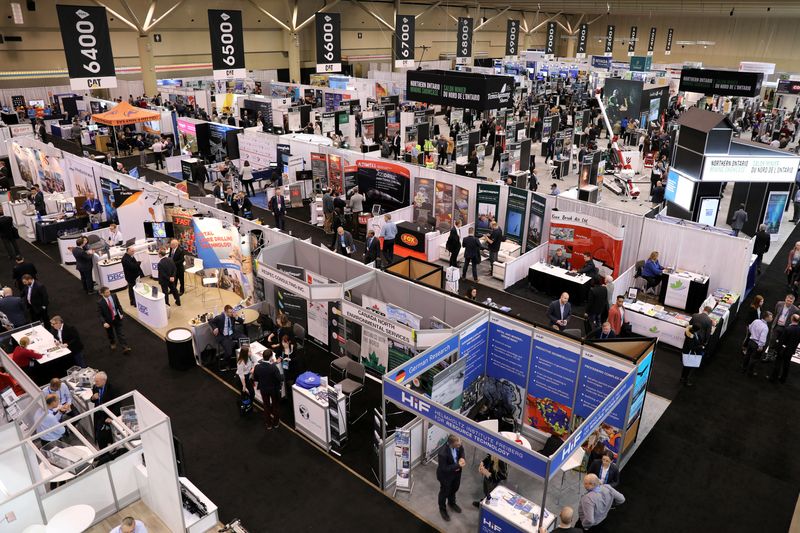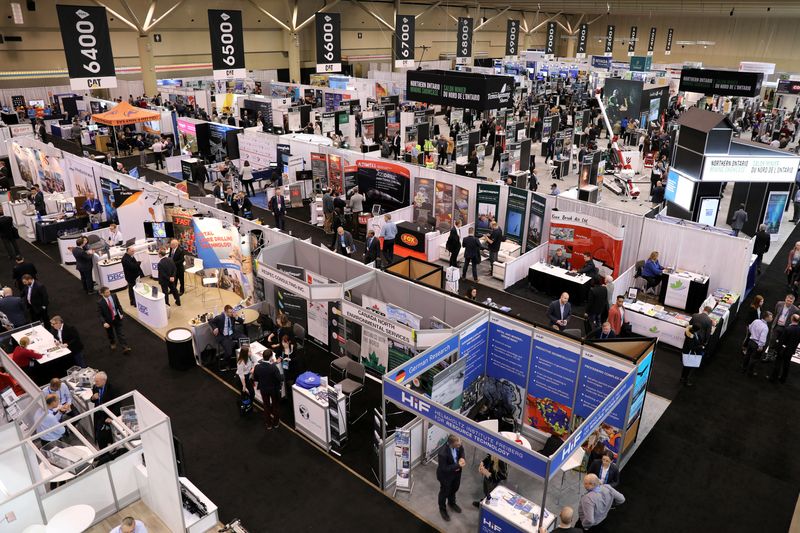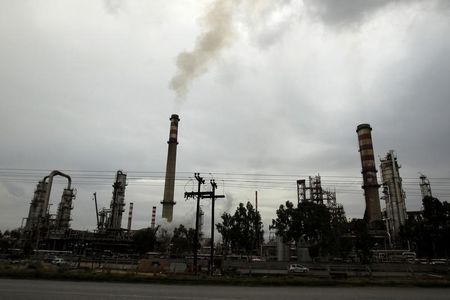Commodities
Canada concerned about critical metals market manipulation, minister says


© Reuters. FILE PHOTO: Visitors crowd booths at at the Prospectors and Developers Association of Canada (PDAC) annual conference in Toronto, Ontario, Canada March 1, 2020. REUTERS/Chris Helgren/File Photo
By Divya Rajagopal
TORONTO (Reuters) -Canada is concerned about market manipulation and dumping in key metals used in electric vehicle batteries, a federal Canadian minister told Reuters, adding the country wants to explore a U.S.-mooted alternative pricing model.
Canada, along with Australia and the U.S., is looking to develop its critical mineral supply chain to break the monopoly of China which controls over 90% of key metals that are crucial for energy transition.
“There will be significant incremental demand for critical minerals going forward, but we do have some challenges right now with prices and clearly we are concerned about issues relating to market manipulation and dumping,” Energy and Natural Resources Minister Jonathan Wilkinson said this week, adding the concerns are shared by many democratic countries.
Dumping refers to an anti-competitive trade practice when a country exports certain products at a price lower than what is sold in its home country.
The minister said the topic will be discussed during the annual Prospectors and Developers Association of Canada (PDAC) conference in Toronto, one of the world’s largest gatherings of mining companies and their financiers, that starts on Sunday.
Wilkinson said there is still some way to go before Canada and its allies solve the issue of dumping, but one of the ideas being discussed is the concept of an alternative pricing mechanism.
The U.S. Department of Defense plans to develop a program to estimate prices and predict supplies of critical minerals to boost market transparency.
Wilkinson said Canada does not want to be in a position like Germany which was reliant on Russia for cheap .
“We need to find pathways through which we are developing resources outside of Chinese influence.”
The mood at the four-day PDAC gathering will be dour, as miners are buffeted by weaker demand and plummeting prices. Lithium and nickel prices have fallen by over 70% and 40% respectively in the past year, forcing many to cut production and cut jobs.
The S&P TSX Venture Metals and Mining index is down 28% year-on-year.
In Canada, which is home to about 40% of the world’s listed mining companies, the slump in battery metal prices has impacted companies’ ability to raise funds. Canadian miners say the commodity crash, macroeconomic challenges and the government’s increased scrutiny of foreign deals have led to a feeling that Canada is not as attractive a destination for capital formation as it was a few years before.
“I think Canada has lost its shine with regards to capital formation,” said Dominique Barker, Chief Financial Officer, Lithium Royalty Corp, adding that better policy alternatives in countries such as Australia are making them more attractive to investors.
Ottawa’s move in 2022 to force three Chinese companies to divest from Canadian listed companies citing national security concerns has cast a shadow on inbound deals in the mining sector.
“The decision (of asking Chinese companies to divest) dissipated or reduced the ability for transactions to occur during a very active phase of fund raising,” said Ali Haji, CEO of ION Energy, a lithium exploration company with a project in Mongolia.
Commodities
Oil set for weekly gain on signs of improving demand

By Shariq Khan
NEW YORK (Reuters) – Oil prices rose in Asian trading hours on Friday, with global benchmark Brent set for its first weekly increase in three weeks on signs of improving global demand and slowing inflation in top oil consumer the United States.
prices rose 21 cents, or 0.3%, to $83.48 a barrel by 0018 GMT. U.S. West Texas Intermediate (WTI) crude futures rose 18 cents, or 0.2%, to $79.41 a barrel.
Brent futures are set to rise about 1% on a weekly basis, and WTI futures are set to gain 1.4%.
Recent declines in oil and refined products inventories at major global trading hubs have created optimism over oil demand growth, reversing a trend of rising stockpiles that had weighed heavily on prices in prior weeks. Through Thursday, Brent crude futures were down around 10% from this year’s peak of $92.18 a barrel on April 12.
U.S. oil and fuel inventories fell last week, while Singapore’s middle distillate fuel stocks dropped to a near three-month low this week. In Europe’s Amsterdam-Rotterdam-Antwerp trading hub, gasoline stocks were down 7.5% in the week to Thursday, data from consultancy Insights Global showed.
Recent economic indicators from the United States have fed into the optimism over global demand. U.S. consumer prices rose less than expected in April, data showed on Wednesday, boosting expectations of lower interest rates in the country.
Those expectations were further bolstered by data on Thursday that showed a stabilizing U.S. job market.
remove ads
.
Lower interest rates could help soften the U.S. dollar, which would make oil cheaper for investors holding other currencies and drive demand.
“Financial markets now have placed the most bets on a September interest rate cut by the Federal Reserve, which would continue to temper the dollar strength and shift that strength over to commodities and equities,” StoneX oil analyst Alex Hodes said on Thursday.
Commodities
Goldman Sachs discusses what’s next for natural gas prices

Over the past three weeks, US prices have surged 30% to above $2.50 per million British thermal units (mm/BTU), fueled by production declines and increased feedgas demand for liquified natural gas (LNG) exports.
Moreover, recent producer cuts, maintenance events, and Freeport LNG’s normalization of gas demand post-outage have contributed to this rise. Cheniere’s announcement of no heavy maintenance for its liquefaction trains this year also supports higher prices.
In a Thursday note, Goldman Sachs strategists said the return of gas prices above $2/mmBtu aligns with their expectations, as production curtailments “would ultimately lead to lower storage congestion risks for this summer.”
“That said, we see only limited further upside from current levels, with stronger gas prices risking a return of congestion concerns,” they added.
Goldman notes that prices above $2/mmBtu reduce gas competitiveness compared to coal, with a $0.50/mmBtu increase potentially cutting gas demand by 1 billion cubic feet per day (Bcf/d), especially in shoulder months.
Moreover, higher prices may prompt the restart of previously shut-in wells. EQT (ST:), the largest producer in the Appalachia region, indicated it would resume production if prices sustainably exceed $1.50/mmBtu. And while Appalachia prices haven’t risen as much as NYMEX, the local hub has averaged $1.44/mmBtu month-to-date, up 10¢ from last month, strategists highlighted.
Elsewhere, European gas prices have also risen this summer, though less sharply than in the US.
Title Transfer Facility (TTF) prices increased 18% over the past three months to around 30 euros per megawatt-hour (MWh), holding steady in May.
remove ads
.
However, unlike the US market, this rally lacks fundamental support, with Northwest (NW) European gas storage at record-high levels, Goldman strategists pointed out.
“To be sure, NW European LNG imports have remained weak relative to last year – and are likely to get weaker in the coming weeks owing to a seasonal decline in global LNG production, exacerbated by outages at Australia’s Gorgon export project,” they said.
“Going forward, we expect healthy non-European demand for LNG to continue to incentivize a decline in European LNG imports vs last year,” they continued.
Commodities
Gold prices trim some weekly gains on tempered rate cut hopes

Investing.com– Gold prices fell slightly on Friday, trimming some of their gains for the week as comments from a slew of Federal Reserve officials offered a more sobering outlook on interest rate cuts.
The yellow metal had risen to nearly $2,400 an ounce this week in the immediate aftermath of some soft U.S. economic readings. But it pulled back from these levels on Thursday and Friday.
steadied at $2,377.40 an ounce, while expiring in June fell slightly to $2,381.10 an ounce by 00:19 ET (04:19 GMT).
Gold retreats as Fed officials downplay rate cuts, but weekly gains due
The yellow metal fell on Thursday after a string of Fed officials cautioned against bets on immediate reductions in interest rates.
Several members of the central bank’s rate setting committee said the central bank will need much more convincing that inflation was coming down beyond a marginally soft inflation reading for April.
This saw traders begin pricing out some expectations for a rate cut in September. The and also rebounded from earlier losses this week.
Still, some softer-than-expected readings put gold on course for a 0.7% weekly gain.
The yellow metal was also in sight of a record high of above $2,430 an ounce, although it appeared unlikely the level would be met in the near-term.
Other precious metals retreated on Friday, but were set for bumper weekly gains. fell 0.2% but were trading up 6.2% for the week, while fell 0.4% but were up 4.5% this week.
remove ads
.
Copper mixed amid middling China cues
Among industrial metals, one-month copper futures tumbled from two-year highs tracking middling economic data. But three-month copper futures pushed higher and were set for a stellar week as markets bet on tighter supplies and an eventual demand recovery in the coming months.
on the London Metal Exchange rose 0.6% to $10,445.0 a ton, while rose 0.3% to $4.8935 a pound.
Data from China on Friday painted a mixed picture of the economy. While grew more than expected, growth slowed and shrank at an accelerated pace. Growth in Chinese also slowed.
The readings presented a muddled outlook for the world’s biggest copper importer, as it rolled out more stimulus measures to shore up growth.
Three-month copper futures gained on the prospect of a demand recovery, and were up nearly 4% this week. They were also at two-year highs.

 Forex2 years ago
Forex2 years agoForex Today: the dollar is gaining strength amid gloomy sentiment at the start of the Fed’s week

 Forex2 years ago
Forex2 years agoHow is the Australian dollar doing today?

 Forex1 year ago
Forex1 year agoUnbiased review of Pocket Option broker

 Forex2 years ago
Forex2 years agoDollar to pound sterling exchange rate today: Pound plummeted to its lowest since 1985

 Cryptocurrency2 years ago
Cryptocurrency2 years agoWhat happened in the crypto market – current events today

 World2 years ago
World2 years agoWhy are modern video games an art form?

 Stock Markets2 years ago
Stock Markets2 years agoMorgan Stanley: bear market rally to continue

 Economy2 years ago
Economy2 years agoCrude oil tankers double in price due to EU anti-Russian sanctions

































